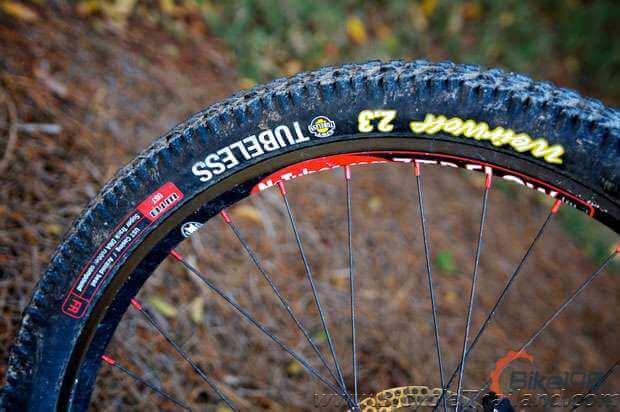Setting your MTB up tubeless may appear to be a daunting task. However, with the right tips, it is easily achievable. This guide contains everything you need to know for a simple, mess-free tubeless setup.
Never heard of tubeless? In our ultimate guide to MTB tubeless, we explain everything you need to know about the pros and cons of tubeless, tubeless repair, tires and much more!
Setting your bike up tubeless is a lot easier than it may seem, and the performance benefits are huge!There really is no cheaper, easier and more effective upgrade for your bike than setting up your wheels tubeless. However many people still seem to prefer using inner tubes, often because they dread the installation process. We’ll show you how easy it can be and promise you won’t cover your living room in tire sealant.
Difficulty: easy
Time required: 15-30 mins per tire
Before you start your tubeless setup, you should make sure you have the necessary parts and equipment ready. You will need tubeless-ready rims and tires (check out our tire group test to find the best tubeless tire for you), sealant and a pair of tubeless valves. If your rims are not pre-taped, you will need to install tubeless-specific rim tape as otherwise, the rim bed won’t be airtight. To inflate the tire, you may need a tubeless inflator pump which we tested in a separate article.
Quick checklist – here’s what you need for a tubeless setup
In order to set your tires up tubeless, it is essential that both the tires and rims are tubeless-ready. Luckily, almost all current tires and rims are tubeless-ready these days. The next step is to check if your rim is pre-taped. Pre-taped rims only require you to install a valve and sealant before mounting and inflating the tire. If your rims are pre-taped, lucky you! For the purposes of this guide, we are going to assume the rims are not taped and require a full setup.
If your rims are pre-taped, lucky you! For the purposes of this guide, we are going to assume the rims are not taped and require a full setup.
Before installing the tubeless tape, make sure your rims are very clean and dry and make sure that you have the correct size of tape for your rim’s internal width. Use isopropyl alcohol (which evaporates after doing its job) and a clean rag to ensure there is no dirt or oily residue left in the rim bed. Then, starting 5 cm to the left of the valve hole, carefully begin to apply the tape 12 cm (5”) at a time, taping clockwise and maintaining constant force to ensure the tape is under tension. While maintaining tension, firmly press down the section you have just applied using your thumb. Repeat this process until you meet the start of the tape. Continue for one more section, overlapping the valve hole. Then, carefully cut the tape and press down firmly.
While maintaining tension, firmly press down the section you have just applied using your thumb. Repeat this process until you meet the start of the tape. Continue for one more section, overlapping the valve hole. Then, carefully cut the tape and press down firmly.
Locate the valve hole, and carefully puncture the tape using a pointy round pick (or similar). Using a round spike to create the valve hole ensures a clean circular puncture, as opposed to a knife or razor which cuts a long slice in the tape that is prone to splitting. Insert the valve into the rim and carefully push it through the valve hole, making sure the base of the valve sits flush with the rim tape. Then, add the valve lock-nut and tighten until it is finger-tight. Never use pliers or tools to do this job – you don’t want to be stuck mid-ride with a mechanical and an impossibly tight lock-nut or risk damaging your precious carbon rims.
Then, add the valve lock-nut and tighten until it is finger-tight. Never use pliers or tools to do this job – you don’t want to be stuck mid-ride with a mechanical and an impossibly tight lock-nut or risk damaging your precious carbon rims.
Before mounting the tire, make sure to check the orientation arrow on the sidewall. Sit one bead of the tire into the rim, and install one side of the tire. Pro tip: make sure to align your tire logo with the valve. Then, starting opposite the valve, push the other tire bead into the rim using both hands. By resting the rim on your legs or the floor you can push the tire bead deep into the rim. The closer you get to the valve, the harder it will get. Make sure that both tire beads are sitting as deep in the rim as possible – this gives you as much slack as possible to install the last part of the bead.
Make sure that both tire beads are sitting as deep in the rim as possible – this gives you as much slack as possible to install the last part of the bead.
The easiest and cleanest way to install tubeless sealant is by adding straight through the valve. In order to do this, you simply have to remove the valve core and squirt the sealant in using a sealant injector or nozzle bottle. Then just re-fit the valve core. Alternatively, the sealant can be added before the final section of bead is seated into the tire. We recommend 80-120 ml of sealant per tire. It’s not worth saving weight by using less sealant – skimping here will reduce the effectiveness of the system dramatically.
Step 5: inflating the tireSome tire and rim combinations will inflate easily using just a standard track pump. However, you may need a tubeless inflator pump for some combinations.
All that’s left now is to inflate your tire. Using a tubeless inflator pump makes this a lot easier. However, it is also possible to inflate some tire and rim combinations with a standard track pump. If your tire is being stubborn, you can remove the valve core to increase airflow. Once inflated, give the wheel a spin and a shake to make sure the sealant coats the inside of the tire evenly. Pro tip: take your bike for a short spin immediately after successfully inflating the tire to test the setup and let the sealant coat the tire.
Pump up the tire WITHOUT the valve core: this increases the airflow into the tire and has often worked miracles for us. Just remember to install the valve core immediately after removing the pump to prevent air loss. Even if you do lose most of the air, the tire bead will now be sitting perfectly in the rim bed and can easily be re-inflated.
Use some Schwalbe Easy-Fit or soapy water on the sidewalls: If the tire is putting up a fight, some soapy water or Schwalbe Easy-Fit will help the tire beads slip into place in the rim.
Use a tire booster or compressor: if your standard track pump is not doing the trick, a tubeless inflator or compressor will most certainly help to blast the tire into place. If in doubt, ask a friend or your local bike shop for help!
Use 2 layers of rim tape: this will make for a tighter fit between the tire and rim
CO2 and tubeless – do they work together?
While CO2 does help to re-inflate your tire in a pinch, it can also have negative long-term effects on your sealant. When CO2 is released from its pressured canister into the much bigger tire volume, a drastic drop in temperature occurs. This temperature drop activates the coagulant of some sealants, causing them to freeze and forming large balls of latex inside the tire. Rides just as bad as it sounds.
Rides just as bad as it sounds.
Is tubeless sealant bad for the environment?
Most tubeless sealants are based on natural or synthetic latex, which is degradable. However, each brand adds different additives and particles to their sealant to improve its performance. Therefore it is impossible to determine exactly how eco-friendly sealants are, as it varies from brand to brand.
Can I mix tubeless sealants?
We do not recommend mixing tubeless sealants, even if both sealants are latex-based. This is because different manufacturers use different additives and particles, which can cause coagulation and degradation of performance if mixed.
How do I get sealant residues off of my components?
If you get tubeless sealant on your rims, components or floor whilst setting up your tires simply wipe it up with a wet paper towel and clean the area with isopropyl alcohol.
Does the sealant evaporate over time?
Tubeless sealant can dry out over time, reducing its effectiveness. How fast it dries out depends on where you ride (how hot the climate is) and how often you ride. When sealant totally dries up it often forms a skin or spiky latex ball inside your tire, rendering it useless.
How fast it dries out depends on where you ride (how hot the climate is) and how often you ride. When sealant totally dries up it often forms a skin or spiky latex ball inside your tire, rendering it useless.
Check out our ultimate guide to tubeless if you want to learn everything there is to know about tubeless, from maintenance to repairs and more!
Did you enjoy this article? If so, we would be stoked if you decide to support us with a monthly contribution. By becoming a supporter of ENDURO, you will help secure a sustainable future for high-quality mountain bike journalism. Click here to learn more.
Words & Photos: Finlay Anderson
Tubeless systems have been around a few years for mountain bikes with obvious benefits. Without inner tubes, there is no need to worry about dreaded pinch flats which occur when the tube is pinched between the ground and the rim. And, without worrying about pinch flats, you can run much lower tire pressure which means better traction. Not to mention, if you do get a thorn in your tire or a small tear from an encounter with a rock, the sealant inside your tire can save you from getting a flat.
And, without worrying about pinch flats, you can run much lower tire pressure which means better traction. Not to mention, if you do get a thorn in your tire or a small tear from an encounter with a rock, the sealant inside your tire can save you from getting a flat.
Now that tubeless has entered the world of road cycling, what are the benefits?

So, what are you waiting for? Ready to go tubeless?
Learn more about Giant Tubeless Wheel Systems and additional helpful How-to Information here.
1.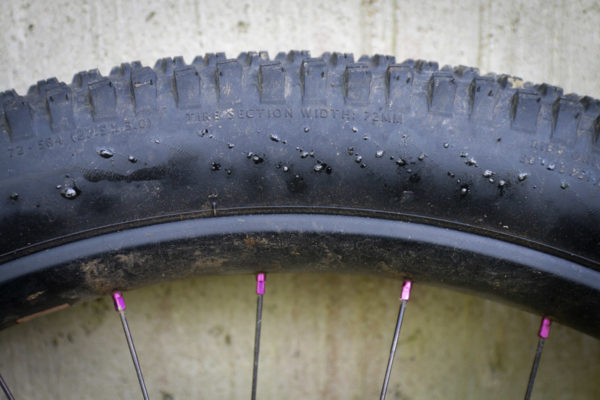 Ensure your tires and rims are tubeless-ready. Don’t worry, it should say so right on the label!
Ensure your tires and rims are tubeless-ready. Don’t worry, it should say so right on the label!
2. Remove your wheel from your bike.
3. Remove the tire and tubes from the rim. Check out our Fix-a-Flat guide for tips on removing your wheel, tires, and tubes.
4. If your rim is wrapped with a plastic rim strip that is not tubeless compatible, remove the rim strip.
5. Tape rim using tubeless-specific rim tape.

6. Using a metal pick or a small Phillip’s head screwdriver, poke a hole where the valve stem will be inserted. Be careful not to make this hole too big.
7. Insert tubeless valve stem into the valve hole and secure using plastic O-ring and washer provided.
8. Put the tire on the rim. If the tire is directional, make sure it is on correctly. Get more tips on how to change a tire by checking out our Fix-A-Flat Guide.
9. Insert recommended amount of tubeless sealant into the tire.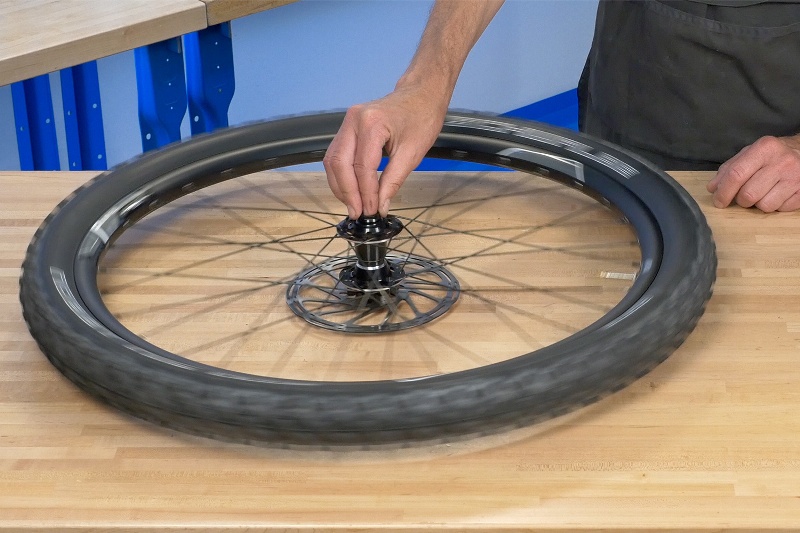 There are two different ways of doing this:
There are two different ways of doing this:
10. After the tire is mounted completely onto the rim with sealant inside, roll the tire on the ground to disperse the sealant. Pull the bead of the tire to the edge of the rim, if possible.
11. Inflate the tire! The best way to get the tire to seal is to add air as quickly as possible. That is why using an air compressor is the best method. If you do not have access to an air compressor, use a charger pump, like the Giant Control Tank Tubeless Inflator.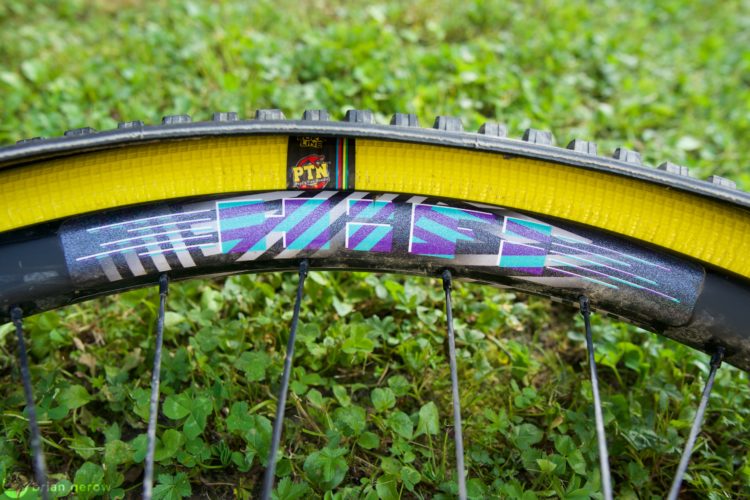
PRO TIP: Are you using an air compressor or tubeless inflator system and still having trouble getting your tire to inflate? Try removing the valve core on your tubeless valve. This will allow air to enter your tire even faster than it would through the valve. Just be careful once you remove the inflator nozzle from the valve since all the air will rush back out of the tire! Be ready with your finger to hold the air in and quickly replace the valve core with your tool.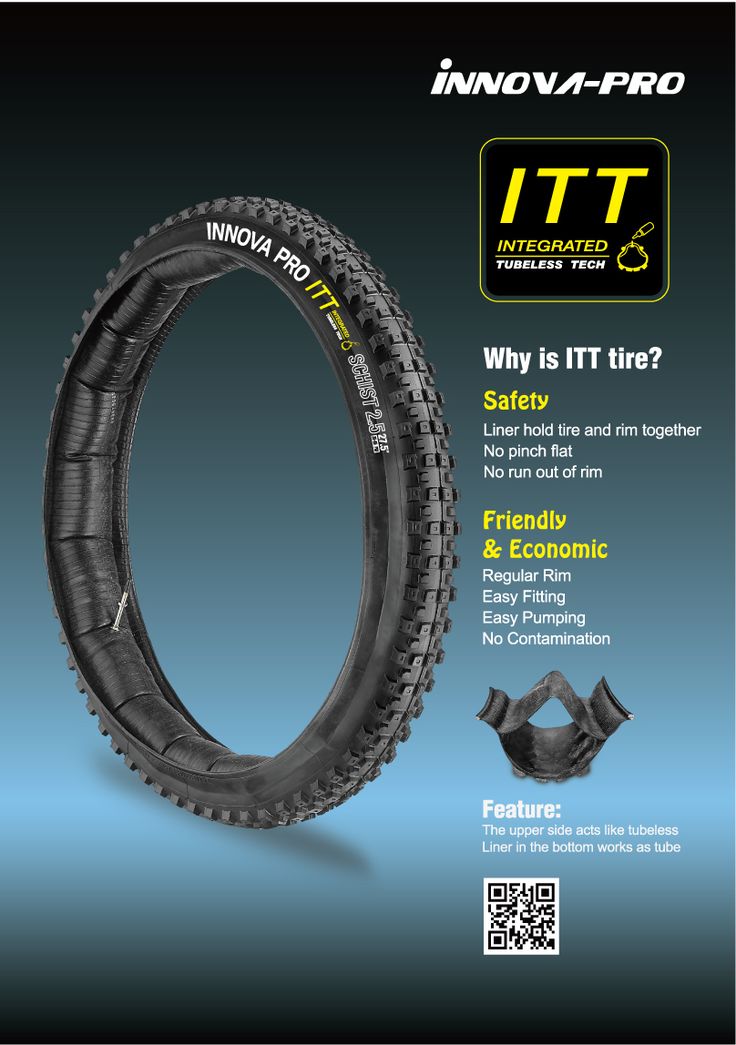
12. After the tire is inflated and the bead is seated, bounce the tire on the ground. This will help disperse the sealant inside of the tire.
13. Replace your wheel and take your bike for a spin. Riding your bike right after setting the tires up tubeless will ensure a good seal.
14. You did it!
*If your tires are already set up tubeless and you are just changing to new tires, disregard steps 5-7. Remove any old sealant with an absorbent cloth and check your rim tape for damage before putting the new tire on.
*Over time, the sealant inside your tires will dry up and stop protecting you from pesky flats. Hot/ dry climates will cause the sealant to dry up faster. Check your sealant levels by shaking the wheel while it is off the bike. You should be able to hear the sealant sloshing around inside. If you can’t hear anything, you need to add more sealant! Otherwise, check your levels/ top off your sealant every 30 days.
Riding your bike is an important step before starting the tire fitting process.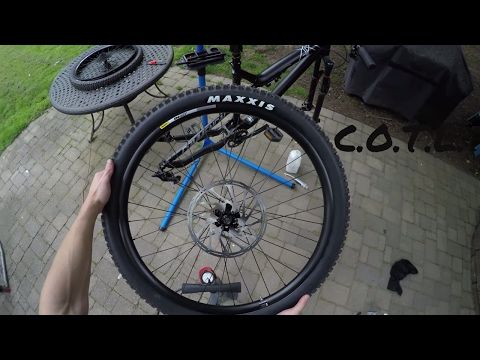 When you buy a tubeless tyre, it essentially means that you are getting a rim that is perfectly cut and fitted to the tubeless tyre. But over time, the tape wears off, resulting in flat tires, and you need to re-glue the entire wheel again.
When you buy a tubeless tyre, it essentially means that you are getting a rim that is perfectly cut and fitted to the tubeless tyre. But over time, the tape wears off, resulting in flat tires, and you need to re-glue the entire wheel again.
Rim tape at a glance
Rim tape is a fabric, PVC or nylon material wrapped around the inner channel of the rim. For tube bikes, this actually helps keep the inner tube from being pierced by sharp spoke nipples when the spokes are threaded into the wheel. But for tubeless tires that come with the same spoke holes on the rim, the solid tape acts as a shield to make the tire more airtight so it doesn't deflate quickly. So, before you start cycling, be sure to stick on some strong airtight tape and expect your wheel to last long before it wears out. nine0003
To effectively re-glue a wheel, or simply apply a new layer of tape to the bare rim bed, you need to use the correct technique while working. At first, it may seem impossible to replicate factory precision when taping, but with the right technique, you can get the job done efficiently.
Rim Tape Installation Step by Step Guide
Choose the right ribbon - Choosing the right ribbon is one of the most important things you don't want to get confused about. The general rule is to find a band that is a few millimeters wider than the size of the actual inner rim width. The tape should ideally reach both sides of the rim even after the middle section is pressed hard against the groove. If you feel that the size of the tape does not fit, perhaps too large compared to the width of your rim, you can cut it with a knife to the desired size. It's always recommended to use branded rim tape, but if yours is cheap, try overlapping the tape two or three times to keep it strong. Gorilla Tape can be a decent cost effective solution here. nine0003
Remove old tape - Your bike may already have old rim tape wrapped around the rim assembly that needs to be replaced. So, before proceeding with pasting, let's safely remove the previous one.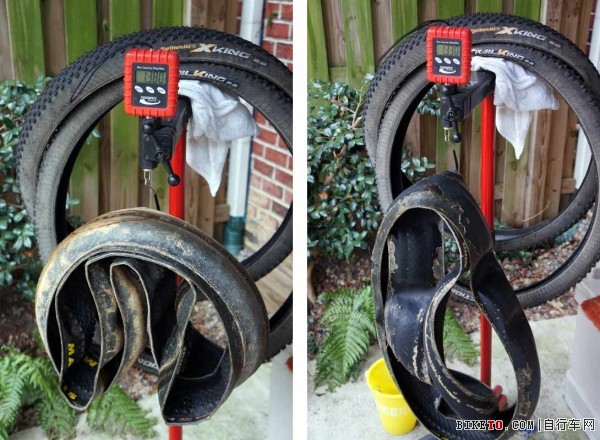
Clean Rim - Now that the old rim tape has been removed, consider cleaning the base of the rim. Thorough cleaning is required before tape is applied, and a dose of acetone or isopropyl alcohol will do the job. You can also use denatured alcohol to clean it, but let's make sure the rim gets very clean so it can be taped. Sometimes you may come across old sealant that has leftover grease left on it after you remove the old tape. For best results, allow the rim to dry for some time after cleaning and give it a final wipe before gluing. nine0003
Tape Rim - Once the rim is nice and clean, the important task of laying the tape on the bottom of the rim comes. As a general rule, you start with the half-spoke holes just behind the valve hole. When you find a spot, pinch the tape with your finger and start applying it along the center channel of the rim. Simply press the tape against the center mounting channel without losing it when you apply the tape with your thumb or forefinger.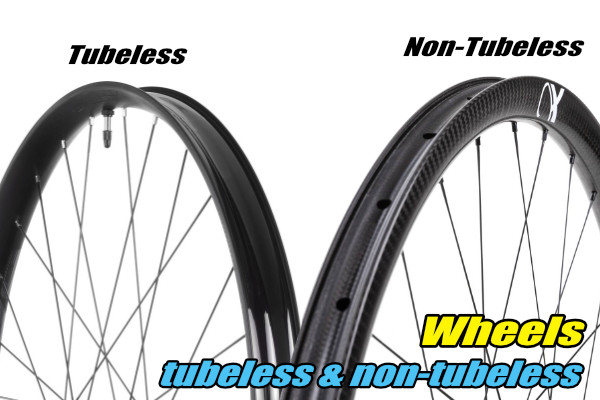 The best way is to take 6-8 inches of tape out of the package, glue the front of it to the rim, and start gluing it around the rim. Glue the tape to the center channel of the rim as tightly as possible and repeat the same, keeping the tension high. Ensures it stays right in the center channel perfectly. When you're done with the tape, check for air bubbles and wrinkles and smooth it out with your fingers or any other blunt object. nine0003
The best way is to take 6-8 inches of tape out of the package, glue the front of it to the rim, and start gluing it around the rim. Glue the tape to the center channel of the rim as tightly as possible and repeat the same, keeping the tension high. Ensures it stays right in the center channel perfectly. When you're done with the tape, check for air bubbles and wrinkles and smooth it out with your fingers or any other blunt object. nine0003
Install the valve - Then locate the hole in the valve and pierce it with a sharp object like a soldering iron. Correctly install the valve nut with retaining ring. You can apply lubricant to the entire retaining ring so that it can be easily removed in the future. Roll it hard later when the tire is installed and inflated to make the tire nice and tight.
Put on the tire - You can simply use your hands and handles to install the tire, or use the lever to do so. Now you have a cool hack that will make your life easier: you can apply a thin layer of wax before mounting the tire to the rim for a smooth fit. Use a pair of rubber gloves for a secure grip and carefully set the tire all around the rim. You can also use tubeless sealant after the tire is fully installed. Finally, use a pump to pump air inside to maintain the recommended tire pressure. Go for a walk to adjust the tire and you're done. nine0003
Use a pair of rubber gloves for a secure grip and carefully set the tire all around the rim. You can also use tubeless sealant after the tire is fully installed. Finally, use a pump to pump air inside to maintain the recommended tire pressure. Go for a walk to adjust the tire and you're done. nine0003
Rim Taping not only helps tubeless fit properly, it also helps your wheel run at lower tire pressures without punctures. With the help of the manual methods mentioned above, we have tried to show you how to set up a tubeless system on your bike along with the tape.
Tubeless tires can hardly be called the know-how of the bicycle industry, however, they still raise questions for many. The topic itself, as a rule, is surrounded by a lot of skepticism and distrust, which are more often explained by a lack of understanding of basic things and a lack of experience in riding such wheels. To dispel all these doubts, we answer the main questions related to tubeless technologies. nine0003
nine0003
These are bicycle tires that do not have a tube. At the same time, tubeless technology is not only about tires. We are talking about a whole wheel system, which also includes a special rim and a sealant that gives the wheel anti-puncture properties. The tubeless concept makes the bike more comfortable to use and improves its riding performance, which will be discussed in order.
How long ago did this technology appear and can it be trusted? nine0003
Those who hear about bicycle tubeless for the first time usually tend to be suspicious of them. You can dislike this technology for subjective reasons, but you definitely shouldn’t distrust it. Tubeless tubes have been massively used for cars and motorcycles for several decades, and during this time they have not given reason to doubt their reliability.
The first tubeless systems for bicycles appeared in 1999, when the French rim brand MAVIC collaborated with tire manufacturer Hutchinson to present their concept of a simple and effective tubeless wheel. In the 2000s, this technology remained the prerogative of mainly professional athletes, who quickly appreciated its main advantages: lighter weight, more air in the wheel, good "traction" and durability. nine0003
In the 2000s, this technology remained the prerogative of mainly professional athletes, who quickly appreciated its main advantages: lighter weight, more air in the wheel, good "traction" and durability. nine0003
In recent years, tubeless has finally ceased to be perceived as something exotic. For example, today a significant part of the MTB and almost all touring cars come with such wheels as standard. A wide variety of sealants are also available on the market, and the number of those who are discovering the benefits of tubeless technology is steadily increasing.
The tubeless system provides a special rim and tires that are labeled tubeless ready or TR. However, the rims themselves are easy to distinguish visually - they have a low side and characteristic walls with recesses, forming a kind of lock in which the tire cord is wedged when air is injected. Due to this, in the inflated state, the rubber reliably and hermetically “sits” on the rim, without breaking off the wheel even at low pressure. The rim itself is additionally glued with a sealing tape, after which the nipples are installed separately. nine0003
The rim itself is additionally glued with a sealing tape, after which the nipples are installed separately. nine0003
The benefits of tubeless wheels are revealed no matter how often and what kind of bike you ride: whether it's weekend trips, extreme downhill or long-distance touring. Nevertheless, for certain categories of cyclists tubeless still open up more opportunities: first of all, we are talking about those who are seriously passionate about off-road.
When actively driving off-road with tubeless tubes, you can ride on lowered wheels and at the same time not be afraid of such an unpleasant type of puncture as a snake bite. Low tire pressure, in turn, gives better handling, dampens vibrations more effectively and generally provides more comfort on difficult tracks. If we are talking about cyclists, then they appreciate tubeless for their anti-puncture qualities. nine0003
Road bikes also use tubeless wheels. Moreover, they are the pioneers of this technology. But road tubeless tubes are a different story: they are designed for different operating pressures and have tangible design differences. Therefore, further we will talk mainly about those tires that are put on mountain, touring and city bikes.
But road tubeless tubes are a different story: they are designed for different operating pressures and have tangible design differences. Therefore, further we will talk mainly about those tires that are put on mountain, touring and city bikes.
These are the two rim formats that define the features of a tubeless wheel assembly. BST is a standard that involves the installation of a special sealing tape that prevents air from leaking through the holes in the spokes. This is the most common version of tubeless systems. nine0003
UST is a blind rim in which an additional bridge isolates the spoke holes. Thus, there is no need for laying a sealing tape. In practice, this greatly simplifies life, because when installing a tire (especially without proper experience), the tape tends to crush, which is why you have to reassemble the wheel. It is easy to guess that such rims also have a drawback - their price.
The tubeless system in the form in which we wrote it above is already a full-fledged wheel, it can be installed on a bicycle and hit the road. But there is an important nuance. First of all, tubeless tubes are valued for their anti-puncture qualities: for this, a small amount of a special liquid, a sealant, is poured inside the tire. nine0003
But there is an important nuance. First of all, tubeless tubes are valued for their anti-puncture qualities: for this, a small amount of a special liquid, a sealant, is poured inside the tire. nine0003
Yes, you can. But you should not do this. Firstly, this is illogical: for no reason you are depriving yourself of the main advantage of tubeless - the anti-puncture effect. But more importantly, it is very difficult (or even impossible) to inflate such a tire in a completely flat state with a portable pump: to do this, you need either a strong floor pump or a booster. Naturally, no one will take such bulky things with them on the road. Filled with sealant 95% of punctures "seal" without a critical loss of pressure, and in most cases there is no need for even light pumping. Thus, the probability of being with a flat tire is very low.
So, if you put tubeless, sealant is still needed. Such fluids are easy to find in any bike shop, they are inexpensive and require replacement on average once every three to four months, so there is no need to talk about any inconvenience. Yes, in order to cope with the fill, you need to acquire a certain skill, but this is much easier than constantly changing broken cameras. In addition, sealant can be replaced once a season in a specialized service. nine0003
Yes, in order to cope with the fill, you need to acquire a certain skill, but this is much easier than constantly changing broken cameras. In addition, sealant can be replaced once a season in a specialized service. nine0003
Bicycle sealants are based on fine particles (rubber or polymer fibers) suspended in a liquid carrier. Inside the wheel, the sealant does not polymerize: it is in a liquid state and is distributed along the inside of the tire during movement. When a puncture occurs, the air flow begins to push the solution out. A fine suspension clogs the hole, and the sealant dries quickly. Thus, there is a reliable "sealing" of the puncture. nine0003
If we talk about typical punctures - collisions with thorns, wires, small glasses - such damage is self-healing without a noticeable loss of pressure. Usually, a puncture can only be guessed from a small spot on the surface of the tire. Naturally, the sealant works with more complex damage. You can count on it even if you pierce the wheel with a thick nail, 4-5 mm in diameter.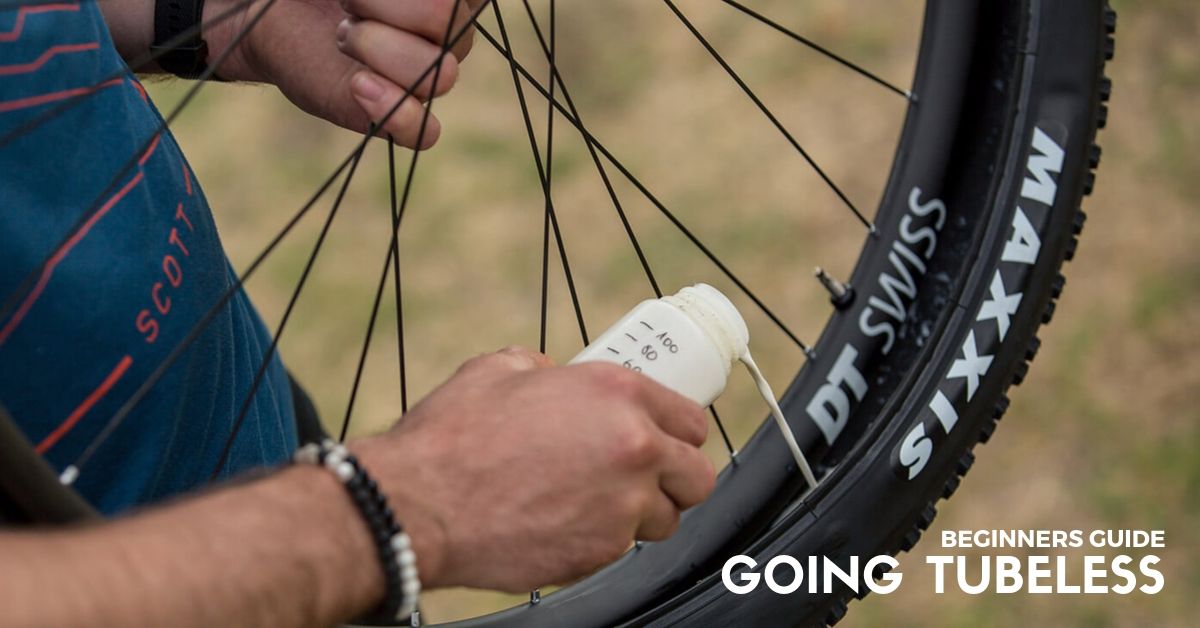 If you don't understand how a liquid can seal such holes, you can watch numerous crash tests on YouTube that demonstrate the miraculous properties of sealants. nine0003
If you don't understand how a liquid can seal such holes, you can watch numerous crash tests on YouTube that demonstrate the miraculous properties of sealants. nine0003
The consumption per tire is from 50 to 100 ml. If we are talking about standard MTV tires, the golden mean is about 60 ml per wheel. The exact dosage will always be written on the bottle. It is difficult to get confused even for those who do not like to read instructions: most sealants have measuring containers or a dosage scale on the bottle itself.
Here, too, everything is conditional and depends on the characteristics of the specific composition and intensity of punctures. In the absence of serious damage that entails the leakage of a large volume of sealant, you can easily skate a whole season on one fill. Some cyclists prefer to do an incomplete start-up gas station and gradually add 20-30 ml of fluid every two to three months. You can also navigate by how effectively the sealant works: if you see that small punctures are sealed with a strong deflation of the wheel, it may be that the composition is no longer enough and it needs to be added. Be that as it may, sealant is a very economical thing that lasts for a long time. nine0003
You can also navigate by how effectively the sealant works: if you see that small punctures are sealed with a strong deflation of the wheel, it may be that the composition is no longer enough and it needs to be added. Be that as it may, sealant is a very economical thing that lasts for a long time. nine0003
The sealant inside the tubeless tends to dry out, forming a characteristic film. Whether or not to clean the tire cavity is up to you. This is a purely aesthetic moment, which does not affect the operation of the anti-puncture fluid. The sealant can simply be added as it dries and not bother with unnecessary worries. It is more likely that the tire will completely wear out than it will have time to completely clog with dried filler.
nine0117
Serious damage - large diameter punctures, small cuts, run over nails with subsequent tire rupture - are repaired using special repair worms. These are rubber or fibrous bands that are inserted into the hole to reduce its area and allow the sealant to seal the puncture.
These are rubber or fibrous bands that are inserted into the hole to reduce its area and allow the sealant to seal the puncture.
With long longitudinal cuts it is more difficult. Here you need to either sew up the dissection with nylon threads, or stick a patch on the inside of the tire. You don’t have to worry about the tightness of the repair site - the sealant will do this work, of course, if it does not have time to leak out. But being able to inflate a completely flat tire with only a portable pump will require skill. nine0003
In fairness, we note that such complex injuries are rare for most cyclists. But for those who are seriously passionate about off-road, it is better to play it safe with a spare camera. In this case, having caught a cut, you can always drain the sealant, unscrew the nipple from the rim and install a regular camera. And in order not to drive with a “hernia” protruding outward, we recommend placing, for example, a bill folded in half under the cut on the tire.
Tubeless allows you to forget about such an unpleasant form of damage as a "snake bite" forever. It usually happens when at full speed you catch a pothole in the pavement, unsuccessfully jump onto a curb or run into a stone on a downhill. Hitting the edge of a hard object, the tire is crushed, and the rim walls work like incisors, damaging the chamber in two places. In tubeless wheels, this scenario is excluded, because. there is nothing to break through here. Of course, it can be assumed that the rim will cut the tire itself, but this should be a blow of enormous force, which is almost never encountered in practice. nine0003
Rejection of the chamber increases the volume of air in the wheel. This changes the contact patch (it becomes flatter) and allows the wheels to better absorb off-road bumps. Add here the ability to ride at low pressure, without being afraid of a snake bite, and it becomes completely clear why tubeless lovers of hard off-road riding so idolize.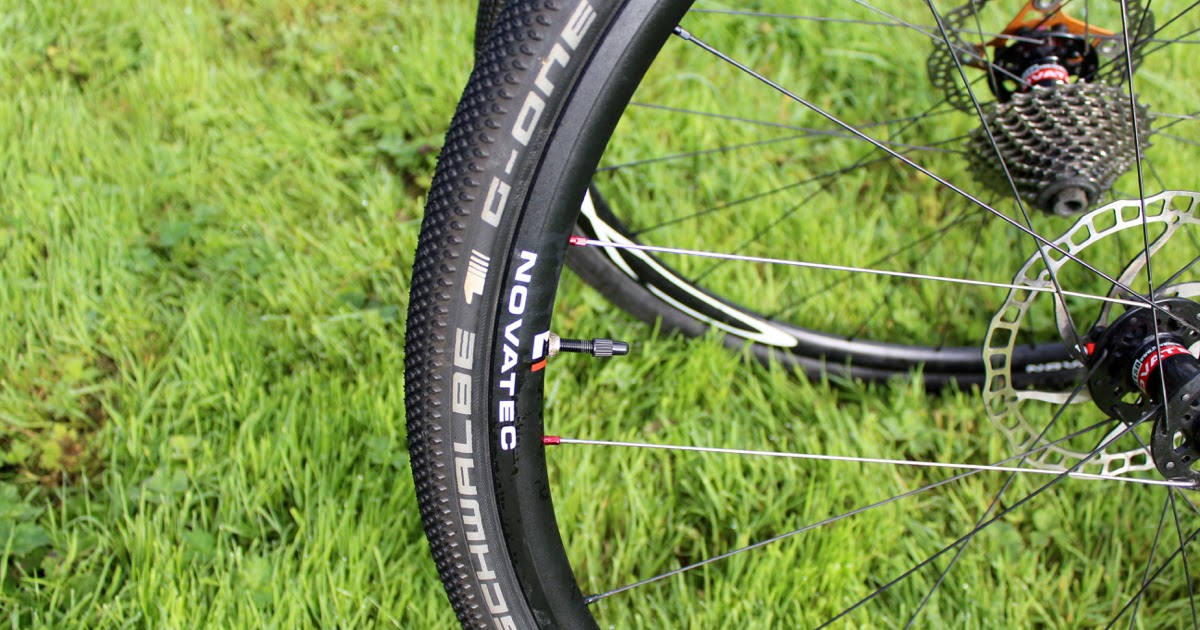 Soft tires with a large contact patch "fit" all the bumps in the road, giving excellent traction on rocks, forest primers and other off-road. nine0003
Soft tires with a large contact patch "fit" all the bumps in the road, giving excellent traction on rocks, forest primers and other off-road. nine0003
In addition to traction, tubeless tires improve shock absorption, dampen vibrations better, and generally provide more off-road comfort. At the same time, to get the most out of this rubber, you need to experiment a lot with tire pressure, trying to find the indicators that will best suit your individual riding style.
Finally, the camera is extra grams. By refusing them, you can save an average of 70-100 g of weight on each wheel. For some, this may seem like a formality, but it is worth considering the fact that extra grams on the periphery of the wheel have a stronger effect on driving performance. This difference is especially felt on road bikes: road bikes, gravel, touring. nine0003
They also exist. Moreover, it is far from formal. First, it's the price. The difference becomes especially noticeable when you buy tubeless systems separately: rims, tires + small things (tape, removable nipples, sealant). For tubeless you will have to pay an average of one and a half times more than for ordinary wheels, plus or minus the same class. And if we are talking about more advanced UST rims, then this means another + 30-40% to the cost.
For tubeless you will have to pay an average of one and a half times more than for ordinary wheels, plus or minus the same class. And if we are talking about more advanced UST rims, then this means another + 30-40% to the cost.
With tubeless by default, everything is more difficult in terms of installation (here we are talking about conventional BST systems). You need to learn how to properly glue the tape, accurately insert the nipples, carefully install tight rubber, making sure not to displace the tape and not fill everything with sealant. On the other hand, all this comes with experience, but what you will always have to put up with is the difficulty with pumping a completely flat tire.
A tubeless tube cannot be inflated until its landing board snaps into place on the rim. To do this, you need to sharply introduce air into the tire. The tire should straighten up and fall into the grooves with a characteristic click - then it can be safely pumped further. This all sounds simple if there is a compressor in the garage. Putting a tubeless tube into the grooves by pumping air with an ordinary floor pump is quite difficult, and almost impossible with a portable bicycle pump. nine0003
Putting a tubeless tube into the grooves by pumping air with an ordinary floor pump is quite difficult, and almost impossible with a portable bicycle pump. nine0003
All this makes life much more difficult. But there are solutions. In the field, a compact can of compressed air can help out. At home, installing tubeless tubes greatly simplifies the booster. This is a cylinder into which a high pressure is pumped with a pump, then it is connected to a nipple, the valve is lowered - and the air from the reservoir pumps up the wheel sharply.
As you can see, tubeless cameras also have enough disadvantages, but it is wrong to consider them in isolation from the advantages. For example, the probability of being with a completely flat tire away from home is very low, due to the anti-puncture qualities. Complicated installation is offset by the lack of punctures and roadside repairs. And by overpaying in price, you save on interchangeable cameras, and, of course, win as a roll on off-road.